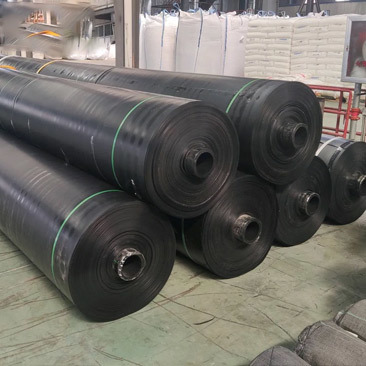The Benefits of Composite Geomembranes for Retention Ponds: A Comprehensive Guide
Release time:
2025-09-28
The Benefits of Composite Geomembranes for Retention Ponds Table of Contents 1. Introduction to Composite Geomembranes 2. What Are Composite Geomembranes? 3. Advantages of Using Composite Geomembranes in Retention Ponds 3.1 Durability and Longevity 3.2 Environmental Protection 3.3 Cost-Effectiveness 3.4 Installation and Maintenance Ease 3.5 Custo
The Benefits of Composite Geomembranes for Retention Ponds
Table of Contents
- 1. Introduction to Composite Geomembranes
- 2. What Are Composite Geomembranes?
- 3. Advantages of Using Composite Geomembranes in Retention Ponds
- 3.1 Durability and Longevity
- 3.2 Environmental Protection
- 3.3 Cost-Effectiveness
- 3.4 Installation and Maintenance Ease
- 3.5 Customization Options
- 4. Applications of Composite Geomembranes in Retention Ponds
- 5. Case Studies
- 6. Frequently Asked Questions
- 7. Conclusion
1. Introduction to Composite Geomembranes
Composite geomembranes play a pivotal role in the construction and maintenance of retention ponds. Their unique structure, combining two or more materials, offers unparalleled performance in various environmental conditions. As we delve into the benefits of these geomembranes, we will uncover why they are becoming the preferred choice for engineers and environmentalists alike.
2. What Are Composite Geomembranes?
Composite geomembranes are manufactured from a combination of materials, typically incorporating a flexible geomembrane layer and a protective geotextile layer. This design enhances the overall performance, offering significant advantages over traditional single-layer membranes. The robust construction ensures that these geomembranes are not only impermeable but also resistant to punctures, tears, and various chemical substances.
3. Advantages of Using Composite Geomembranes in Retention Ponds
The use of composite geomembranes in retention ponds comes with several advantages that can significantly enhance the functionality and longevity of these water management systems.
3.1 Durability and Longevity
One of the most compelling benefits of composite geomembranes is their **durability**. These materials are designed to withstand harsh environmental conditions, including extreme temperatures, UV radiation, and chemical exposure. This resilience not only extends the lifespan of the pond but also reduces the need for frequent repairs, making it a wise investment for any construction project.
3.2 Environmental Protection
Composite geomembranes provide excellent environmental protection by preventing water contamination. They create a reliable barrier that stops pollutants from leaching into the groundwater. By using these geomembranes, project managers can ensure compliance with environmental regulations and protect local ecosystems, which is critical in today’s environmentally-conscious society.
3.3 Cost-Effectiveness
While the initial investment in composite geomembranes may be higher than traditional options, the long-term savings are substantial. Their durability translates to reduced maintenance costs and fewer replacements over time. Moreover, preventing leaks and contamination can save significant expenses associated with environmental cleanup.
3.4 Installation and Maintenance Ease
The installation process for composite geomembranes is generally straightforward, which can save time and labor costs. The lightweight nature of these membranes allows for easier handling and placement. Furthermore, their low maintenance requirements mean that once installed, they require minimal oversight, making them an attractive option for project managers.
3.5 Customization Options
Composite geomembranes come in various thicknesses, colors, and designs, allowing for customization to meet specific project needs. They can be tailored to fit the unique requirements of different retention pond designs, ensuring optimal performance and efficiency.
4. Applications of Composite Geomembranes in Retention Ponds
The applications of composite geomembranes in retention ponds are diverse and impactful. They are used in agricultural settings for irrigation ponds, in urban areas for stormwater management, and in industrial applications for waste containment. Their versatility makes them a go-to solution for various water management challenges, providing both functionality and sustainability.
5. Case Studies
Numerous projects worldwide have successfully utilized composite geomembranes in retention ponds, showcasing their effectiveness.
- **Case Study 1: Agricultural Irrigation Pond**
In a large-scale agricultural operation, composite geomembranes were implemented to create an irrigation pond. The result was a significant reduction in evaporation losses and improved water quality for crop irrigation.
- **Case Study 2: Urban Stormwater Management**
A metropolitan area faced recurrent flooding issues due to inadequate stormwater management. The installation of composite geomembranes in retention ponds effectively managed excess runoff, reducing flood risks and enhancing water quality.
- **Case Study 3: Industrial Waste Containment**
In an industrial setting, composite geomembranes were employed to contain hazardous waste materials. The barrier provided by the geomembranes ensured that no contaminants leached into the surrounding environment, thereby protecting public health and safety.
6. Frequently Asked Questions
What is the lifespan of composite geomembranes?
Composite geomembranes can last several decades, depending on environmental conditions and maintenance practices. Typically, they offer a lifespan of 20 to 30 years.
How do composite geomembranes compare to traditional membranes?
Composite geomembranes offer superior durability, puncture resistance, and environmental protection compared to traditional single-layer membranes, making them a preferred choice for many projects.
Can composite geomembranes be recycled?
Yes, some composite geomembranes can be recycled, depending on the material composition. It's essential to consult with manufacturers for specific recycling guidelines.
What are the typical applications for composite geomembranes?
They are widely used in retention ponds, agricultural irrigation, stormwater management, and hazardous waste containment, among other applications.
How do I choose the right thickness for a composite geomembrane?
The thickness required will depend on the specific application, environmental conditions, and regulatory requirements. Consulting with an expert can help determine the optimal thickness for your project.
7. Conclusion
In summary, the use of composite geomembranes in retention ponds presents a multitude of benefits, including enhanced durability, environmental protection, cost-effectiveness, and ease of installation. As industries and municipalities seek sustainable solutions to manage water resources effectively, composite geomembranes will undoubtedly play a critical role in the future of construction and environmental conservation. By investing in these innovative materials, project managers not only safeguard their investments but also promote a greener, more sustainable planet.






